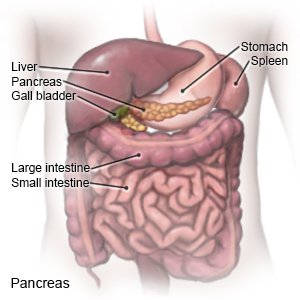Pancreatic Stent Placement
Medically reviewed by Drugs.com. Last updated on Apr 6, 2025.
What do I need to know about pancreatic stent placement?
A stent is a small tube used to widen a pancreatic duct and keep it open. Pancreatic fluid normally flows through the ducts. Smaller ducts empty fluid into the main duct. A stent can help treat a narrow, blocked, or leaking duct, or drain extra fluid. One or more stents may be placed before certain procedures to prevent pancreatitis (inflammation of the pancreas). Pancreatic stent placement may be done during endoscopic retrograde cholangiopancreatography (ERCP).
 |
How do I prepare for stent placement?
- Your healthcare provider will talk to you about how to prepare for your procedure. He or she may tell you not to eat or drink anything after midnight on the day of your procedure. Tell your provider about all medicines you currently take. He or she will tell you if you need to stop any medicine before your procedure, and when to stop. He or she will tell you which medicines to take or not take on the day of your procedure.
- Tell your provider about all allergies you have. Tell him or her if you had an allergic reaction to a medicine, contrast liquid, anesthesia, or antibiotics.
- Arrange to have someone drive you home from your procedure.
Drugs used to treat this and similar conditions
Creon
Creon (pancrelipase) contains digestive enzymes and is used to improve food digestion in people who ...
Zenpep
Zenpep (pancrealipase) is used to replace pancreatic enzymes when the body does not have enough of ...
Ozempic
Learn about Ozempic (semaglutide) for type 2 diabetes treatment, weight management, cardiovascular ...
Albutein
Albutein is used for burns, external, hypoproteinemia, pancreatitis, peritonitis, postoperative ...
Pancreaze
Pancreaze (pancrelipase) is used to treat exocrine pancreatic insufficiency. Includes Pancreaze ...
Flexbumin
Flexbumin is used to treat patients suffering from shock, blood loss and severe burns. Learn about ...
Pancreatin 4X
Pancreatin 4X is used for chronic pancreatitis, cystic fibrosis, pancreatitis
Alburx
Alburx is used for burns, external, hypoproteinemia, pancreatitis, peritonitis, postoperative ...
Viokace
Viokace (pancrelipase) is used to treat exocrine pancreatic insufficiency due to chronic ...
What will happen during stent placement?
- You will be given medicines to help you relax, make you drowsy, and prevent coughing or gagging. Your healthcare provider will insert the endoscope into your mouth. An endoscope is a long tube with a camera and a light. The provider will move the endoscope until it reaches your small intestines. He or she will use the camera to find the opening to the duct.
- Your provider may use a balloon to widen the duct. He or she will guide a wire into the duct. The stent will be put into the duct over the wire. Fluid may be removed. Contrast liquid will be injected to make the duct and stent easier to see in pictures. The pictures will help make sure the stent is in the correct position.
What should I expect after stent placement?
- You may have a sore throat for a day or two.
- You may have abdominal pain or feel bloated. You may also feel nauseated. These symptoms should go away in a few hours.
- You will need to have x-rays 3 to 4 weeks after the procedure to make sure the stent it still in place.
What are the risks of pancreatic stent placement?
The endoscope or tools may damage your pancreas or the duct. The stent may move out of place or block the duct. The stent may become stuck in your small bowel. The procedure may not work and you may need to have another stent placed.
Care Agreement
You have the right to help plan your care. Learn about your health condition and how it may be treated. Discuss treatment options with your healthcare providers to decide what care you want to receive. You always have the right to refuse treatment. The above information is an educational aid only. It is not intended as medical advice for individual conditions or treatments. Talk to your doctor, nurse or pharmacist before following any medical regimen to see if it is safe and effective for you.© Copyright Merative 2025 Information is for End User's use only and may not be sold, redistributed or otherwise used for commercial purposes.
Further information
Always consult your healthcare provider to ensure the information displayed on this page applies to your personal circumstances.
